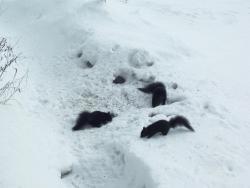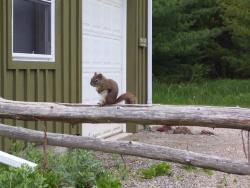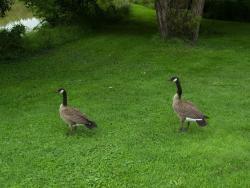If you feed the birds, or even if you don’t, the chances are that you have tree squirrels in your yard. Many gardeners, who plant small bulbs only to have them dug up and eaten, curse at the mention of squirrels and refer to them as tree rats. Bird-lovers fume when the food they provide for the birds is consumed by the rodents. However, when you eventually have time to sit and watch the goings-on in your garden, you may come to appreciate squirrels as entertainment.
Two types of squirrels frequent my garden. The largest is the eastern gray squirrel, Sciurus carolinensis. Here in south-central Ontario this squirrel’s fur is most commonly black or very dark brown, but it can also be silvery gray mixed with orange.

Some startling combinations can arise, with ears or tails of different colors. I have seen a silver squirrel with bright orange ears, a black squirrel with a brown tail, a brown squirrel with an orange tail, and so on. Other color combinations, and populations of pure white squirrels, occur in other parts of North America east of the Rockies.
The red squirrel, Tamiasciurus hudsonicus, is also common in my garden. More rust than red-colored, it is tiny compared to the eastern gray, but what the red lacks in size it makes up for in speed and spunk. A red can run rings around a gray, and rarely backs down from one. With comparatively large eyes and an appealing white tummy, the red squirrel can look very cute, but I would not want to get too close to its teeth.

Of the two squirrels, the gray is the most enterprising and athletic when it comes to raiding the bird feeders. One year, a gray succeeded in reaching a feeder hung from the washing line. It climbed the wooden siding of the house, clung to the washing line and walked it upside down, and slid down onto the bird feeder, where it held on by its back feet while using its front paws to extract bird food, which it ate while hanging head-downwards.

This year, a gray is testing my DH’s patience by accessing a pole-mounted bird feeder, which has a baffle to prevent squirrels from climbing the pole. The squirrel is leaping onto the feeder from a nearby tree. DH keeps cutting off tree branches, and the squirrel keeps finding new ones to leap from. It is now using a high, thin branch that bends down under its weight, and when the branch rebounds upward the added push extends the squirrel’s leap so it can reach the feeder once again. By spring, DH will have removed half the tree, one branch at a time.
While the vast majority of migratory birds depart south on schedule, now and again there are ones that stay late or never leave at all. Starlings can be forgiven for not always going away with the vast flock of grackles, cowbirds, and red-winged blackbirds that they arrived with, since they are European imports and in their continent of origin they never had a need to go south in winter. However, the lone grackle that is still visiting the sunflower-seed feeder in my garden has no such excuse. A song sparrow has also failed to migrate and is hanging around with a flock of juncos. I suppose for a bird that small, it is safer staying here with others similar in size than setting off on a long journey alone.
The saddest failure to migrate must be a bird unable to fly. What must it be like to desperately need to go south, but not have the means to do so, and to be abandoned by flock and family? As winter ice built up, we became aware that a flightless Canada goose was paddling around on the small patch of open water where the stream flows into our pond. The goose retreated upstream and hid in the reeds when we approached it, but through binoculars we could see that one of its eyes was cloudy, and its wing feathers looked ragged. After failed attempts to lure it out of the reeds with corn so we could catch and relocate it, we could do nothing but let nature take its course.
Days of cold and snow ensued, and we felt sure the goose had succumbed to either injuries or predators. However, when a mild spell melted some of the ice, the goose reappeared on the pond. For several days we watched it eating submerged plants and paddling around strongly in the water. Finally, it had the strength to climb out onto the ice, walk around, and exercise its wings. Just when we thought it would never leave, it took a run and launched itself into the air. Wings laboring hard, it rose up, above the encircling trees, and flew over the hill, southward bound.
Walks in the surrounding woods and meadows are, weather permitting, part of my daily exercise routine. I tend to go out at times of day when hunting activity is low, so as not to provide an inadvertent target, and therefore I don’t often see wildlife. When I do have an encounter, I treasure it all the more.
On a warm, windless, foggy day I was on the mown path crossing a damp meadow when a strong animal scent enveloped me. I hesitated, unsure what it was. As I stood still, sniffing, a deer suddenly sprang to its feet out of the goldenrods and asters in front of me, almost close enough to touch. I don’t know who was more surprised, me or it. I had a moment to appreciate its beauty, and then the deer snorted once and bounded away.
Porcupines have crossed paths with me more than once, but I usually see them up trees, sleeping. On the ground, one large individual contested the right-of-way with me, only moving aside after I repeatedly stamped on the ground. Another one I nearly stepped upon when I was looking upwards while walking in the woods. Hearing a rustle by my feet, I stopped dead in my tracks, and looked down. The porcupine, inches from my toes, turned its back to give me a good look at its fine array of quills before lumbering off into the undergrowth.
Often in the summer I will hear the shrill alarm call of a chipmunk and glimpse one diving into a hiding place among fallen branches. The squirrels are easier to see, as they leap into the trees and survey me from high branches while chattering their displeasure. The raccoons are more discreet, and slip away unseen, although I will sometimes spot one slumbering in the fork of a tree.
It is not my habit to stand still for hours waiting for birds to appear, so avian encounters are rare. The woodpeckers have an uncanny ability to always be on the far side of the tree from me, so I hear them knocking, but can’t see who’s there. Occasionally a ruffed grouse will rocket up from the bushes, scaring the liver out of me. Chickadees are always around, but once they’ve reported my presence, they generally don’t stay close. An exception was made by one chickadee who allowed me to watch him inspect for hidden insects every curl of bark on the trunk a birch tree. Larger birds betray their presence in the woods by the whooshes of air as they flap invisibly away. However, I recently came face to face with a barred owl - about the size of a chicken - that was roosting on a branch overhanging the trail. It contemptuously ignored my attempt at owl-speak, “Who-ooo are you-ooo?”, and never blinked an eye or moved a feather as I sidled past.
One day this summer, a group of twenty-three Canada geese walked across the road from the property of one of our neighbors and made themselves at home on our pond, to the annoyance of our resident two pairs of geese and their eleven offspring. The newcomers were a mixed bunch of all ages, including two very small goslings that did not belong to any of the adults. These two babes must have wandered off, attached themselves to the wrong crowd, and in the process lost their parents. The babes hung around on the fringes of the flock, wanting to be accepted, but although their presence was tolerated, they were pecked by both adults and goslings if they got too close to a family unit.
In due course the adults of the flock regrew their flight feathers after molting, their offspring grew their first flight feathers, and flying lessons commenced. Day by day, the parents increased the height and time they took their children aloft, until one day the whole lot of them flew off and didn’t come back. The two lost goslings, though, had not yet fledged and were left behind.
The abandoned goslings behaved like a male and a female (one was large and prone to standing watch, while the other was demure and petite) and so I named them Hansel and Gretel. The babes stuck together, and when they eventually fledged, Hansel and Gretel began taking little practice flights every morning. They would make one or two circuits of the pond, never rising above the trees surrounding the water, and then come in to land. Gretel was particularly bad at landing, usually taking a nose-dive as soon as her feet hit the water, but she gradually improved.
In mid-to-late August, a new pair of adult geese arrived. Hansel and Gretel immediately began following the adult female around, and since they were not rebuffed I hoped that the youngsters would be adopted. They all spent the day amicably together and then, as evening fell, the adults prepared to fly off and Hansel and Gretel showed every intention of leaving with them. After a lot of honking and false starts they all got facing in the same direction and began take-off across the pond. At the pond’s edge, the adults ascended steeply to rise above a willow tree and the house behind it, but Hansel and Gretel could not gain enough altitude to clear the obstacles and turned back to land on the pond. The adult pair did not return for them. The babes had been abandoned again.
What will become of Hansel and Gretel? Without adult geese to encourage them to fly higher and farther, will they ever develop the strength to leave? Fall is not far off now. All I can do is feed them a little corn to give them energy and hope that more adults will turn up, adopt them, and take them south.

It all started with a bird table and a bird feeder. One feeder was not enough and so my husband installed more, some for sunflower-seeds and some for peanuts. After that, we progressed to offering suet cakes in winter. Many birds appreciated the feeders, but so did the raccoons and squirrels. After a period of experimentation with “raccoon-proof” and “squirrel-proof” seed dispensers and suet cages that raccoons expertly dismantled and squirrels gnawed their way into, we resorted to hanging the feeders from the laundry line. I then felt sorry for the disappointed, hungry squirrels and raccoons, and so I heaped food for them on the bird table. One table was not sufficient, so my husband installed a second, larger one.
Our two-acre fish pond attracts a lot of water-fowl, but most of the visitors are able to feed themselves. However, one hot summer we gained a trumpeter swan so weak from heat-exhaustion that it could not fly, and we needed to provide it extra nourishment in the form of duck pellets and corn kernels. The Canada geese soon noticed the food supply and developed a taste for corn. The following year, when the same geese returned in spring they expected to be fed corn, and we gave in.
One winter, the arrival of a flock of wild turkeys prompted us to bring out the corn again. Then skinny deer turned up and began to pathetically lick sunflower seeds and corn off the bird tables, so we began feeding the deer too. When the snow was deep and hungry rabbits turned to stripping the bark from my ornamental shrubs, we cut branches off wild apple trees for the cottontails to gnaw on. Cute, big-eyed bunnies began congregating, looking for handouts. Nervous in my presence, they just sat immobile while I bounced peanuts off them.
Feeding the wildlife now takes a significant portion of our time and budget. I wonder if we should really be doing it at all. On the one hand, the natural habitat of these creatures has been changed and diminished by the expansion of human farming and building, so we bear some blame for them being unable to find enough food. On the other hand, there’s only so much two old people can do, and we can’t do it indefinitely. Is it right to make wild creatures dependent on us, when we know it’s only temporary, or should we just carry on doing what we can, while we can? There’s also the question of whether it is right to allow wildlife to become a bit tame, since the next human they encounter may be out to kill them.